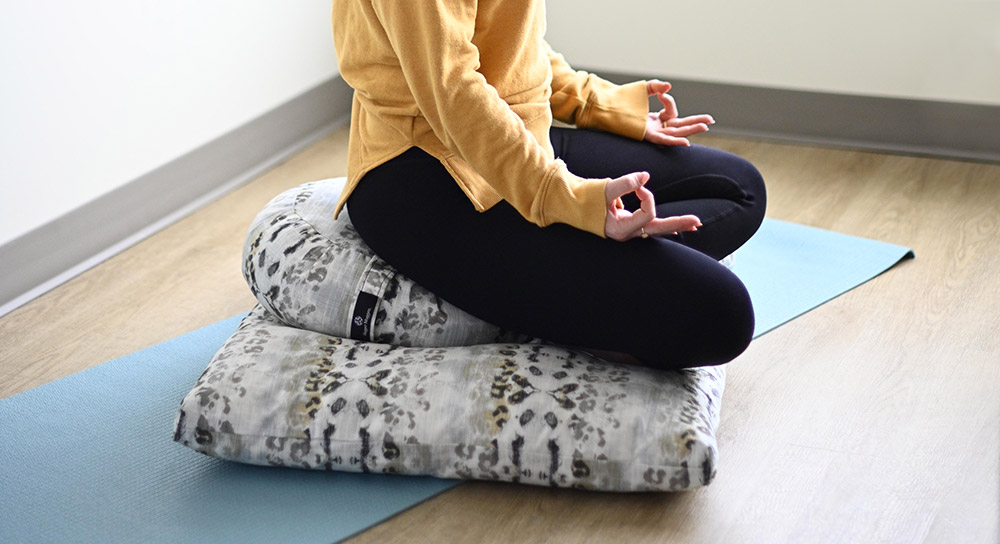
People sometimes chuckle when I tell them that sitting on a meditation cushion is physically rigorous. But it’s true. When you sit still and tune into your body for any length of time, you’re likely to become uncomfortable. And sitting for long periods in the same position will at some point start to make you antsy.
Even in my hour-long meditation class, people sometimes experience physical difficulties. That’s when I work with them to find the best sitting position. How comfortable you are when you’re practicing sitting meditation is largely determined by what you choose to sit on. Each person’s body is different, so I also help them find the right support for their individual body..
It’s All About Your Skeleton
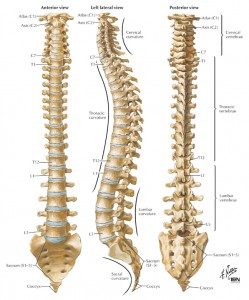
Comfortable sitting depends on your spine’s ability to maintain its natural curves (see illustration). The human spine holds itself up naturally when its curves are in integrity. The position of your sacrum determines your spinal curves. The optimum position for the sacrum is an approximately 30-degree forward tilt. When the sacrum is in that position, the rest of the curves more easily fall into place.
In sitting meditation, because of the shape and structure of our hip joints, or because of inflexibility, the sacrum often ends up in a vertical position, instead of the 30-degree forward tilt. In some cases, the sacrum can even tilt backward instead of forward. When this happens, our lumbar curve has to straighten or even flex forward, causing us to have to use a whole lot of core strength to sit upright. When we spend a lot of energy just to sit upright, we get tired pretty quickly.
How You Sit Matters
While Sukhasana (Easy Cross-Legged Pose) is the traditional sitting position, not everyone can sit this way. Some people’s hip joints easily rotate externally, while others’ more easily rotate internally. If your knees are lower than your hip bones when you sit cross-legged on a meditation cushion, that means your hip joints rotate externally with ease. When your knees are lower than the hip bones, your sacrum will tilt forward, keeping your spinal curves intact. If your hip joints internally rotate more easily, your knees will rise to the level of the hip bones or higher. When your knees are higher than your hip bones, your sacrum will naturally tilt backward, making sitting for long periods uncomfortable.
We need to sit high enough on a meditation cushion or bench so that our sacrum, and therefore our pelvis, can tilt forward so that the spinal curves can fall into place. That is why meditation cushions are designed to give us extra height. Here are some tips on how to choose the best support for your body and your practice:
Zafu and Zen Meditation Cushions
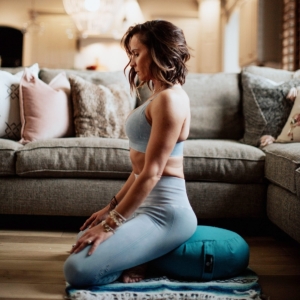
Zafus are the traditional, round meditation cushion. At about five inches high, Zafus will be more than sufficient for comfortable sitting for most people.
Our Zen Cushions are similar in height to our Zafus, but rectangular and wider in shape. Whether you choose the Zafu or Zen is a matter of personal preference. Sitting on the wide side of the Zen Pillow will support the tops of your thighs more than the Zafu will. Some people prefer more thigh support, while others prefer that their upper thighs extend off the edge of their cushion. All in all, the support is very similar between the two of them.
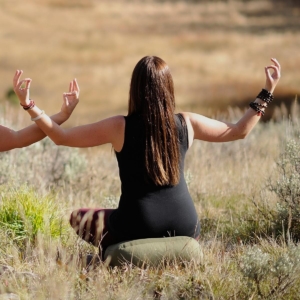
If you’re thinking of trying a Zafu or Zen Cushion for cross-legged sitting, first try sitting on a 5-inch-high stack of firm blankets with your ankles on the floor in front of your blanket stack. Check where your knees land, and if you find that your knees are at hip bone level or higher, Sukhasana might not be your best meditation position.
The good news is that the Zafu and Zen are adaptable. If cross-legged sitting doesn’t work for you, you can turn your Zafu or Zen Cushion on its side. Place it between your thighs and sit on it with your knees bent, shins on the floor on either side of the cushion.
V-Shaped Meditation Cushion
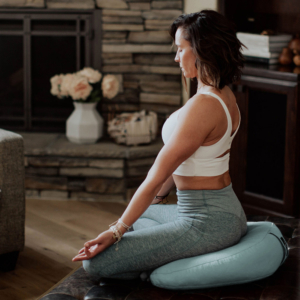
Our V-Shaped Cushion is similar in height and purpose to the Zafu. But here’s what makes me love the V-Shaped Cushion: Because my hip joints externally rotate easily, my legs need more support than traditional cushions can give. The V-Shaped Cushion slants downward so that it supports your entire leg and encourages your pelvis to tilt forward—provided your hips externally rotate as described above.
As with the Zafus, you can check whether a V-Shaped Meditation Cushion is appropriate for you by sitting on a 5-inch stack of firm blankets and observing whether your legs are higher or lower than your pelvis. If your legs can’t rest on the “legs” of the cushion because they are high in the air, the V-Shaped Cushion won’t be comfortable. If you can use a Zafu in a cross-legged position, you will probably also find the V-Shaped Cushion to be comfortable.
All of Hugger Mugger’s meditation cushions are filled with organic buckwheat hulls. The zippered covers allow you to add or subtract filling as you like. Here’s an overview of all the choices.
Zabuton
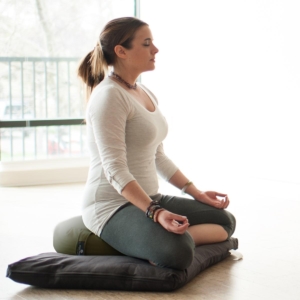
A Zabuton is like a mini-futon. It’s a wide, rectangular, cotton-filled cushion with a removable cotton cover.
Placing a Zabuton under your meditation cushion or bench increases your comfort. Ankle bones, feet or knees pressing against a hard floor may feel okay at first. But over time, even 20 to 30 minutes, it’s likely to get pretty uncomfortable.
A Zabuton is a worthwhile investment if you’re going to commit to a meditation practice.
Sukasana Meditation Cushion
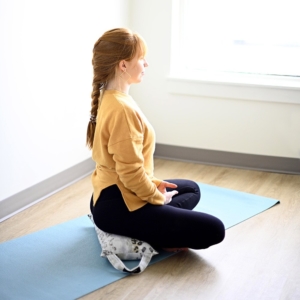
Hugger Mugger’s Sukasana Cushion is a much smaller, portable meditation cushion. While it doesn’t give as much hip support as our other meditation cushions, this small cushion is great for traveling or for taking with you to a yoga studio.
Comfort is Key
Whether you decide to use a Zafu, Zen Cushion, or V-Shaped Cushion is a matter of personal preference. Remember that whatever you choose should allow you to sit comfortably with all your spinal curves intact.
Check out our Meditation Cushion Guide for more info.
If you want to read in more detail about how to sit comfortably, or how to structure a yoga practice to support your sitting, pick up my book Yoga for Meditators. In it I devote several chapters to choosing the right sitting support and finding the optimum sitting position.
Zafuko® Cushions: A Lightweight Alternative
In the last few years, we added another alternative to our meditation cushion collection. Our Zafuko® Cushions are extremely light weight, a great alternative to the heavier meditation cushions and benches we offer. Here’s an article that explains all the options.

Like V shaped
I need a sturdy pillow to give me height from sitting on anything due to very bad knees. Which one is best for just sitting
The pillow that’s best for you depends on how your hip joints are constructed. I’d guess that with a sore knee, you might do better with a Zen Pillow than with some of the others. But not knowing exactly what the issue is, I can’t say for sure.